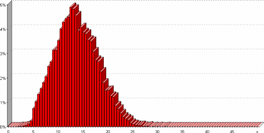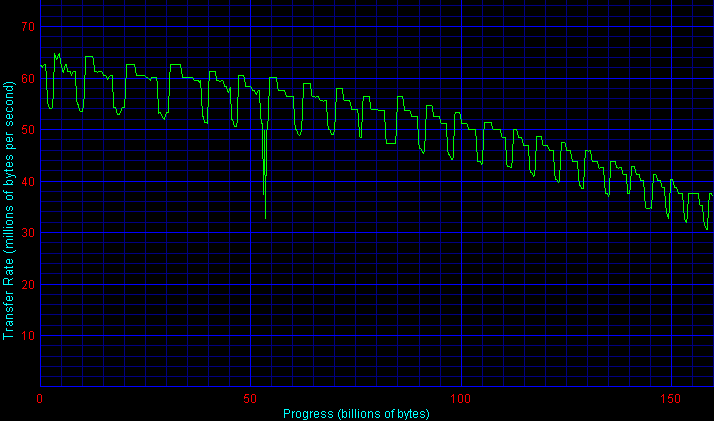Through steady provision of a three-year warranty and whisper quiet operation, Samsung’s SpinPoint series of desktop drives has maintained a small yet loyal following over the years. How does the SATA version of the SpinPoint P80 stack up? StorageReview examines!
Note: Since the publication of this review, this drive has been retested under Testbed4, a newer hardware/software/benchmark platform. Please see this article for updated results. This review remains for reference purposes only.
|
Recently, however, the manufacturer’s marketing apparatus seems to have undergone an overhaul of sorts. While still not as pervasive in local superstores as the major American manufacturers, the firm now demonstrates more willingness to work with publications such as StorageReview to get its products in the light.

The SpinPoint P80 is Samsung’s current performance-oriented 7200 RPM drive line. Though firms such as Seagate and Maxtor have moved to 100 GB/platter products, Samsung, like Hitachi and Western Digital, still rests at the long-standing 80 GB/platter mark. Samsung joins Seagate in topping out with a two-platter design rather than setting its sights against the three-or-more-disk flagships offered by Hitachi, Maxtor, and WD. An 8.9 millisecond seek time and an eight-megabyte buffer round out the drive’s vitals.
Like other firms, Samsung ships the P80 exclusively with fluid dynamic bearing (FDB) motors. When contrasted with traditional ball bearing offerings, FDB motors deliver quieter idle operation as well as purportedly increasing shock resistance.

With the P80, Samsung targets mid- to high-end desktop machines as well as light-duty servers that require moderate capacity combined with performance and quiet operation. In the following tests, the Samsung SpinPoint SP1614C is compared against the following drives for the following reasons:
MaXLine III | Current-generation competitor |
Deskstar 7K400 | Current-generation competitor |
Caviar WD2500JD | Current-generation competitor |
Barracuda 7200.7 | Current-generation competitor |
-->
Low-Level ResultsFor diagnostic purposes only, StorageReview measures the following low-level parameters: Average Read Access Time– An average of 25,000 random accesses of a single sector each conducted through IPEAK SPT’s AnalyzeDisk suite. The high sample size permits a much more accurate reading than most typical benchmarks deliver and provides an excellent figure with which one may contrast the claimed access time (claimed seek time + the drive spindle speed’s average rotational latency) provided by manufacturers. WB99 Disk/Read Transfer Rate – Begin– The sequential transfer rate attained by the outermost zones in the hard disk. The figure typically represents the highest sustained transfer rate a drive delivers. WB99 Disk/Read Transfer Rate – End– The sequential transfer rate attained by the innermost zones in the hard disk. The figure typically represents the lowest sustained transfer rate a drive delivers. |
For more information, please click here.
|
Note: Scores on top are better. |
|
|||||||||||||
|
SP1614C Average Read Service Time
|
||||||||||||
|---|---|---|---|---|---|---|---|---|---|---|---|---|---|
The SpinPoint SP1614C delivers an average read access time of 13.4 milliseconds. When taking into account the 4.2 ms that represents the average rotational latency of a 7200 RPM drive, the Samsung weighs in with a 9.2 ms measured seek time. While a tad off of the firm’s 8.9 ms claim, the raw score nonetheless remains competitive with the competition.
|
Note: Scores on top are better. |
|
|||||||||||||||||||||||||||||
|
|
||||||||||||||||||||||||||||
7B300S0-2 Transfer Rate
|
|||||||||||||||||||||||||||||
According to WinBench 99’s low-level test, the SP1614C’s outer-zone transfer rate hits 60.2 MB/sec. Note, however, the drive’s rather unusual transfer rate graph illustrated above. This “sawtooth” pattern is not unique to this sample- the SP1614C’s PATA brother also exhibits the same behavior. Though it does not officially register in WB99’s test (which quantifies rates with a single number at the very beginning and very end of the range), eyeballing the graph above suggests transfer rates that peak at about 65 MB/sec. In the same vein, while WB99 reports an inner-zone transfer rate of 36.5 MB/sec, the drive actually bottoms out a bit below.
We asked Samsung about the unusual STR graphs that their drives deliver. Their answer:
The “Samsung P80 is using an Adaptive Zone Layout algorithm to maximize head performance that optimizes both TPI (Track Per Inch) and BPI (Bit Per Inch). Other HDD manufacturers are using only TPI optimization during their HDD manufacturing process.”
In other words, the method that Samsung uses to arrange its 80 GB/platter of information across two dimensions in the SP1614C (and PATA 1614N) is very unconventional and does not result in a uniform and consistent drop as one moves towards inner tracks like we see in all other drives.
When it comes down to it, of course, measurement of transfer rates remains a largely diagnostic exercise and has relatively little bearing in application-level performance. It is higher-level results that truly determine how a drive performs. With that, let’s turn to the SR Desktop DriveMarks.
-->
Single-User PerformanceStorageReview uses the following tests to assess non-server use: StorageReview.com Office DriveMark 2002– A capture of 30 minutes of actual computer productivity use that exactingly recreates a typical office-style multitasking environment. The applications include: Outlook XP, Word XP, Excel XP, PowerPoint XP, Calypso (a freeware e-mail client), SecureCRT v3.3 (a telnet/SSH client), CuteFTP Pro v1.0 (an FTP/SSH client), ICQ 2000b), Palm Hotsync 4.0, Gravity 2.3 (a Usenet/newsgroups client), PaintShop Pro v7.0, Media Player v8 for the occasional MP3, and Internet Explorer 6.0. StorageReview.com High-End DriveMark 2002– A capture of VeriTest’s Content Creation Winstone 2001 suite. Applications include Adobe Photoshop v5.5, Adobe Premiere v5.1, Macromedia Director v8.0, Macromedia Dreamweaver v3.0, Netscape Navigator v4.73, and Sonic Foundry Sound Forge v4.5. Unlike typical productivity applications, high-end audio- and video- editing programs are run in a more serial and less multitasked manner. The High-End DriveMark includes significantly more sequential transfers and write (as opposed to read) operations. |
StorageReview.com Bootup DriveMark 2002– A capture of the rather unusual Windows XP bootup process. Windows XP’s boot procedure involves significantly different access patterns and queue depths than those found in other disk accesses. This test recreates Windows XP’s bootup from the initial bootstrap load all the way to initialization and loading of the following memory-resident utilities: Dimension4 (a time synchronizer), Norton Antivirus 2002 AutoProtect, Palm Hotsync v4.0, and ICQ 2000b.
StorageReview.com Gaming DriveMark 2002– A weighted average of the disk accesses featured in five popular PC games: Lionhead’s Black & White v1.1, Valve’s Half-Life: Counterstrike v1.3, Blizzard’s Diablo 2: Lord of Destruction v1.09b, Maxis’s The Sims: House Party v1.0, and Epic’s Unreal Tournament v4.36. Games, of course, are not multitasked- all five titles were run in a serial fashion featuring approximately half an hour of play time per game.
For more information, please click here.
|
Note: Scores on top are better. |
|
|||||||||||||||||||||||||
|
|
||||||||||||||||||||||||
|
|
||||||||||||||||||||||||
The SpinPoint 1614C delivers 410 I/Os per second in the SR Office DriveMark, trailing the formidable showings by the Maxtor MaXLine III and Hitachi Deskstar 7K400 by a significant 15%. The margin between the Samsung and the more modest WD Caviar and Seagate Barracuda, however, is much slimmer.
Differences widen when it comes to the SR High-End DriveMark. Here the SP1614C trails the category-leading Maxtor by about 23%. Seagate’s Barracuda also manages to broaden the gap and leaves the Samsung behind.
Margins between the SpinPoint and most of the competition remain similar in the SR Bootup DriveMark with only the MaXLine rocketing ahead of the pack.
Finally, while the Maxtor and Hitachi remain untouchable in the SR Gaming DriveMark, the SP1614C manages to remain neck-and-neck with the Caviar and Barracuda.
-->
Multi-User PerformanceStorageReview uses the following tests to assess server performance: StorageReview.com File Server DriveMark 2002– A mix of synthetically-created reads and writes through IOMeter that attempts to model the heavily random access that a dedicated file server experiences. Individual tests are run under loads with 1 I/O, 4 I/Os, 16 I/Os, and 64 I/Os outstanding. The Server DriveMark is a convenient at-a-glance figure derived from the weighted average of results obtained from the four different loads. StorageReview.com Web Server DriveMark 2002– A mix of synthetically-created reads through IOMeter that attempts to model the heavily random access that a dedicated web server experiences. Individual tests are run under loads with 1 I/O, 4 I/Os, 16 I/Os, and 64 I/Os outstanding. The Server DriveMark is a convenient at-a-glance figure derived from the weighted average of results obtained from the four different loads. For more information click here. |
|
Note: Scores on top are better. |
|
|||||||||||||||||||||||
|
|
||||||||||||||||||||||
Samsung’s drive delivers a decent showing in the SR File Server DriveMark, vying with Seagate’s Barracuda for the top slot at 125 I/Os per second. In the more read-heavy SR Web Server DriveMark, however, the SpinPoint stumbles and brings up the rear.
-->
Legacy PerformanceeTesting Lab’s WinBench 99 Disk WinMark tests are benchmarks that attempt to measure desktop performance through a rather dated recording of high-level applications. Despite their age, the Disk WinMarks are somewhat of an industry standard. The following results serve only as a reference; SR does not factor them into final judgments and recommends that readers do the same. |
|
Note: Scores on top are better. |
|
|||||||||||||||||||||||||||
|
|
||||||||||||||||||||||||||
-->
Samsung’s SpinPoint series has enjoyed a grassroots following of sorts by those who value low operating temperatures and silent noise floors over sheer performance. At idle, the SP1614C’s sound pressure at a distance of 18 millimeters is 39.4 dB/A and rests among the quietest drives we’ve ever measured. While one may argue that differences below, say, 43 dB/A or so get lost in the noise generated by other parts of the system (or even general ambient noise, for that matter), there’s no denying that the Samsung is quite at home in the ultra-quiet PCs that many enthusiasts build. When seeking, the drive continues to remain among the quietest SR has ever tested. The same two-platter design that likely aids the SP1614C in whisper-quiet operation also helps maintain low temperatures. After running through a heavy load, the drive’s top-plate temperature weighs in at 18.8 degrees Celsius and should integrate into virtually any system with ease.
-->
According to filtered and analyzed data collected from participating StorageReview.com readers, a predecessor of the Note that the percentages in bold above may change as more information continues to be collected and analyzed. For more information, to input your experience with these and/or other drives, and to view comprehensive results, please visit the SR Drive Reliability Survey.
-->
-->
previous post
Maxtor MaXLine III | ||||||||||||||||||||||||||||||||||
